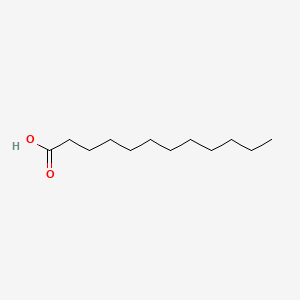| MeSH term | MeSH ID | Detail |
|---|---|---|
| Hemolysis | D006461 | 131 associated lipids |
| Neovascularization, Pathologic | D009389 | 39 associated lipids |
| Lung Neoplasms | D008175 | 171 associated lipids |
| Colonic Neoplasms | D003110 | 161 associated lipids |
| Diabetes Mellitus, Experimental | D003921 | 85 associated lipids |
| Body Weight | D001835 | 333 associated lipids |
| Acne Vulgaris | D000152 | 35 associated lipids |
| Hypersensitivity, Delayed | D006968 | 43 associated lipids |
| Liver Neoplasms, Experimental | D008114 | 46 associated lipids |
| Thrombosis | D013927 | 49 associated lipids |
lauric acid
lauric acid is a lipid of Fatty Acyls (FA) class. Lauric acid is associated with abnormalities such as Infection, Renal tubular disorder, Hypertensive disease, Obesity and Mycoses. The involved functions are known as Transcription, Genetic, Signal Transduction, Mutation, metaplastic cell transformation and Anabolism. Lauric acid often locates in Skin, Plasma membrane, Cytoplasmic matrix, Body tissue and Palmar surface. The associated genes with lauric acid are Gene Family, SLC33A1 gene, Homologous Gene, Open Reading Frames and P4HTM gene. The related lipids are Fatty Acids, Oleic Acids, Palmitates, Stearates and 9,11-linoleic acid.
Cross Reference
Introduction
To understand associated biological information of lauric acid, we collected biological information of abnormalities, associated pathways, cellular/molecular locations, biological functions, related genes/proteins, lipids and common seen animal/experimental models with organized paragraphs from literatures.
What diseases are associated with lauric acid?
lauric acid is suspected in Renal tubular disorder, Hypertensive disease, Infection, Renal vascular disorder, Obesity, Mycoses and other diseases in descending order of the highest number of associated sentences.
Related references are mostly published in these journals:
| Disease | Cross reference | Weighted score | Related literature |
|---|
Possible diseases from mapped MeSH terms on references
We collected disease MeSH terms mapped to the references associated with lauric acid
PubChem Associated disorders and diseases
What pathways are associated with lauric acid
There are no associated biomedical information in the current reference collection.
PubChem Biomolecular Interactions and Pathways
Link to PubChem Biomolecular Interactions and PathwaysWhat cellular locations are associated with lauric acid?
Visualization in cellular structure
Associated locations are in red color. Not associated locations are in black.
Related references are published most in these journals:
| Location | Cross reference | Weighted score | Related literatures |
|---|
What functions are associated with lauric acid?
Related references are published most in these journals:
| Function | Cross reference | Weighted score | Related literatures |
|---|
What lipids are associated with lauric acid?
Related references are published most in these journals:
| Lipid concept | Cross reference | Weighted score | Related literatures |
|---|
What genes are associated with lauric acid?
Related references are published most in these journals:
| Gene | Cross reference | Weighted score | Related literatures |
|---|
What common seen animal models are associated with lauric acid?
There are no associated biomedical information in the current reference collection.
NCBI Entrez Crosslinks
All references with lauric acid
Download all related citations| Authors | Title | Published | Journal | PubMed Link |
|---|---|---|---|---|
| Song B et al. | Description of strain 3CB-1, a genomovar of Thauera aromatica, capable of degrading 3-chlorobenzoate coupled to nitrate reduction. | 2000 | Int. J. Syst. Evol. Microbiol. | pmid:10758860 |
| van der Bijl P et al. | Permeation of sumatriptan through human vaginal and buccal mucosa. | 2000 | Headache | pmid:10759913 |
| Stewart JM and Blakely JA | Long chain fatty acids inhibit and medium chain fatty acids activate mammalian cardiac hexokinase. | 2000 | Biochim. Biophys. Acta | pmid:10760476 |
| Sheffield C | The new laureate speaks. | 2000 | Nature | pmid:10766219 |
| Kamm W et al. | Evaluation of absorption enhancement for a potent cyclopeptidic alpha(nu)beta(3)-antagonist in a human intestinal cell line (Caco-2). | 2000 | Eur J Pharm Sci | pmid:10767598 |
| Ayorinde FO et al. | Determination of the fatty acid composition of saponified vegetable oils using matrix-assisted laser desorption/ionization time-of-flight mass spectrometry. | 2000 | Rapid Commun. Mass Spectrom. | pmid:10775096 |
| Hong JT and Glauert HP | Effect of extracellular matrix on the expression of peroxisome proliferation associated genes in cultured rat hepatocytes. | 2000 | Toxicol In Vitro | pmid:10793296 |
| Govender T et al. | Defining the drug incorporation properties of PLA-PEG nanoparticles. | 2000 | Int J Pharm | pmid:10794931 |
| Sulikowski GA et al. | Investigations into a biomimetic approach toward CP-225,917 and CP-263,114. | 2000 | J. Org. Chem. | pmid:10813939 |
| Hsu AF et al. | Immobilization of Pseudomonas cepacia lipase in a phyllosilicate sol-gel matrix: effectiveness as a biocatalyst. | 2000 | Biotechnol. Appl. Biochem. | pmid:10814587 |
